Site blog
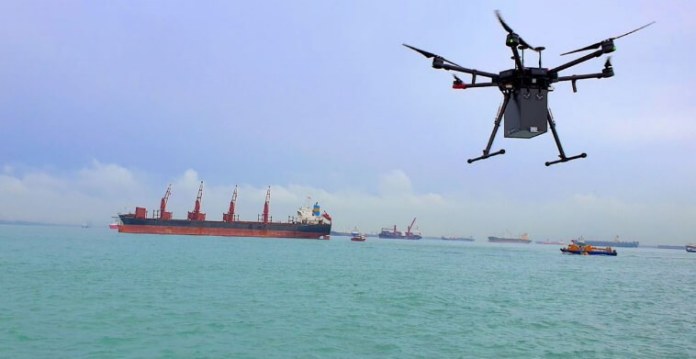
F-drones has completed the first commercial BVLOS drone delivery in Singapore on 19 April 2020. The drone delivered 2 kg of vitamins over 2.7 km in 7 minutes, to a ship managed by Eastern Pacific Shipping (EPS). EPS, which is one of the world’s largest privately-owned ship managers, is F-drones’ first paying customer.
In Singapore, like in most parts of the world, a BVLOS authorisation or permit is required when operating drones beyond the visual range of drone pilots. Without which, commercial drone delivery services would not be viable.
F-drones is the first company in Singapore to receive an authorisation from the aviation authority, to conduct BVLOS drone deliveries to ships in Singapore. For now, this is limited to drone deliveries to ships anchored south of the marina area. This already is a significant milestone for both F-drones and Singapore, as globally, there are only a handful that are operating commercial BVLOS drone deliveries. And F-drones is already working towards expanding their area of operations.
Started little more than a year ago, F-drones is a home-grown startup developing large-scale delivery drones which are fully electric and autonomous. Their goal is to eventually use their proprietary drones, which would be able to send 100kg loads over 100km to ships and offshore platforms. This would help alleviate the pain of sending supplies in marine & offshore applications, which rely on small boats and helicopters.
“These traditional means of transport are expensive, slow, labour and carbon intensive. F-drones’ solutions can help save up to 80% of the costs, time and CO2 emissions. Besides being efficient, delivery drones can also reduce unnecessary human contact amid the COVID-19 pandemic.”, according to Nicolas Ang, CEO of F-drones.
For now, F-drones is using an off-the-shelf drone which can only deliver 5kg loads over 5km. Its CTO, Yeshwanth Reddy, saysthis is “one of the best drones we can buy off the market”. He adds “as the marine & offshore industry requires much bigger loads to be sent over longer distances, F-drones is innovating on the aircraft at a systems-level.”
F-drones plans to complete the development of its 100kg-100km drone in the second half of 2021. Its latest prototype, which is its third, named as Hyperlaunch, would be able to deliver 5kg loads over 50km to ships. F-drones will be starting commercial operations using Hyperlaunch towards the end of 2020, after more tests and improvements. Hyperlaunch in itself is already an attractive product for the shipping industry.
Gil Ofer, the Head of Open Innovation at Eastern Pacific Shipping, says, “EPS has been part of F-drones’ test deliveries since November 2019, when they joined the Eastern Pacific Accelerator powered by Techstars. We believe their solutions will play a significant role in reducing shipping’s overall carbon footprint. The successful BVLOS delivery is a milestone event, and we are extremely proud to be part of their journey.”
F-drones is also working with Hafnia, a world leading product tanker company. Shanker Pillai, Head of Innovation & Change at Hafnia, adds that “We are excited to work with F-drones to develop drone technology with the aim to conduct remote delivery of small packages and emergency deliveries to vessels. Amidst the COVID-19 pandemic, drones can potentially help to reduce human contact during deliveries. We are glad to be part of this development and are looking forward to the first commercial drone deliveries to our vessels.”
Indeed, drones have proven to be of great value in dealing with COVID-19 around the world. F-drones’ BVLOS authorisation is certainly timely, allowing it to commence commercial deliveries at a time when human contact needs to be reduced.
By PRESS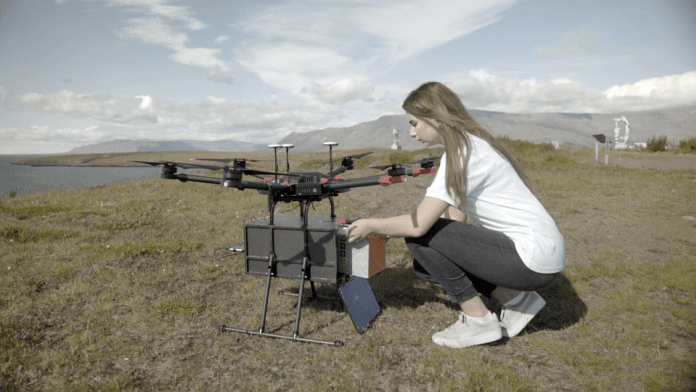
Aerial initiative in Grand Forks, ND aimed at helping address health crisis by delivering food, medicine & essential goods to local backyards and keeping households safe
(Grand Forks, ND. April 24, 2020) – In response to the COVID-19 crisis, leading drone technology company Flytrex, in partnership with EASE Drones, the Grand Forks Region Economic Development Corporation and the City of Grand Forks, announced today the launch of its drone delivery service directly to backyards in Grand Forks, North Dakota. The initiative will provide necessities such as food, medicine and other essential goods via drone to selected households observing social distancing recommendations, helping address the growing health crisis by keeping citizens in the safety of their own homes and reducing crowding and unnecessary contact at local stores.
The deliveries will be made in cooperation with the Northern Plains Unmanned Aerial System Test Site (NPUASTS), with takeoffs taking place across the street from a local shopping supercenter, where provisions will be purchased. During initial stages of the pilot program, deliveries will be offered to a select number of area households which have opted-in to the service.
“In this time of crisis and social distancing, drones provide the ideal solution to bolster delivery capacity while keeping citizens safe at home,” said Flytrex CEO Yariv Bash. “UAVs offer safe, swift and efficient delivery of much needed goods with no risk of unnecessary human contact for consumers. We hope this initiative will alleviate hardships for as many of the people of Grand Forks as possible and help keep them safe and provided for.”
The Flytrex service will meet the highest drone delivery safety standards in full compliance with U.S. Federal Aviation Authority regulations.
“With COVID-19 threatening the wellbeing of our community, our businesses, and our way of life, we are committed to easing the burden on our citizens by leveraging unique resources in this time of crisis,” said Grand Forks Mayor Michael R. Brown. “With innovation in our community’s nature, we are proud to spearhead the use of drones to ensure the health and welfare of our citizens. With the help of Flytrex and EASE Drones, we are deploying UAVs to limit unnecessary exposure to the coronavirus. We hope other communities will follow.”
Flytrex brings significant experience in direct-to-consumer aerial delivery to the North Dakota initiative. In 2017, Flytrex launched the world’s first on-demand urban drone delivery service in Reykjavik, Iceland. In 2018, Flytrex established its first partnership with EASE Drones, launching a fully operational system at King’s Walk Golf Course in Grand Forks. Soon after, in 2019, Flytrex was selected by the FAA to participate in its UAS Integration Pilot Program (IPP) in partnership with the North Carolina Department of Transportation.
“Following our launch in Grand Forks, with the continuing cooperation of local authorities and the FAA, we aim to expand our drone delivery service to help citizens in other areas of the town, the state, and the entire country – as quickly as possible,” added Flytrex CEO Bash.
To read more about the drone delivery initiative and how it is helping with the response to the COVID-19 crisis, go to: https://www.flytrex.com/united-states/grand-forks/
By PRESS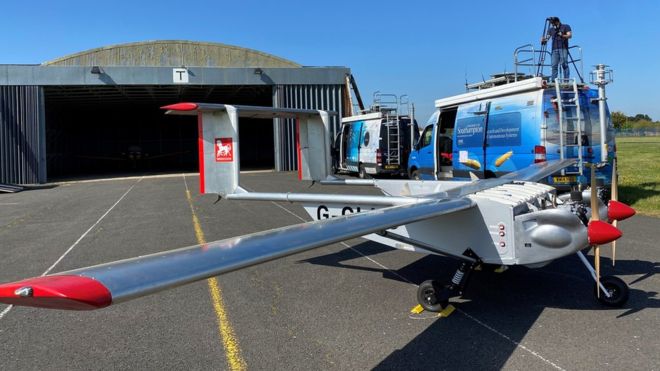
Elliot Smith CNBC The U.K. will next week begin testing drones to deliver medical supplies and equipment to frontline health workers battling the coronavirus pandemic. In a press conference on Friday, Transport Secretary Grant Shapps announced that he had given the green light to begin an £8 million ($9.9 million) testing initiative next week.
The drone testing program, initially launched as part of a £28 million future transport initiative in Southampton and Portsmouth, will be fast-tracked in order to address the “urgent need” for supplies, Shapps said. According to the BBC The trial will use a petrol-fuelled Windracers Ultra fixed-wing drone, capable of carrying 100kg for up to 1,000km (621 miles). However, initially the drone will not carry its maximum payload.
Images and quotes courtesy Elliot Smith CNBC,BBC and Solent transport.
By Ackson Kondwani Mwenda
Well, I don’t want to say, I told you so. But I told you so. Thomas Kirschstein from the University of Martin Luther Halle-Wittenberg, Germany, has discovered that city delivery drones operate at a similar efficiency to diesel vans.
That’s a bad thing. It’s 99% of the feel good story required to push for airspace grabs by large corporate companies.
In this paper an energy consumption model for drones is proposed to describe the energy demand for drone deliveries depending on environmental conditions and the flight pattern. The model is used to simulate the energy demand of a stationary parcel delivery system which serves a set customers from a depot. The energy consumed by drones is compared to the energy demand of Diesel trucks and electric trucks serving the same customers from the same depot.
The results indicate that switching to a solely drone-based parcel delivery system is not worthwhile from an energetic perspective in most scenarios.
A stationary drone-based parcel delivery system requires more energy than a truck-based parcel delivery system particularly in urban areas where customer density is high and truck tours are comparatively short. In rather rural settings with long distances between customers, a drone-based parcel delivery system creates an energy demand comparable to a parcel delivery system with electric trucks provided environmental conditions are moderate.
I am pro delivery drones, I live on a continent with an underdeveloped transport infrastructure with islands of untapped human potential unconnected.
Good news for #VertiportAfrica Drones are competitive in rather rural settings (large distances, low customer density).
The companies to watch in the drone delivery world are those plodding on, actually flying and refining their platforms.
Rendered images of nine winged 17 motored monstrosities being unloaded on a roof top with an insert of just how big the market is need not apply.
By Gary Mortimer
By automating indoor disinfection processes companies can quickly and safely disinfect their buildings with little to no downtime.
OTTAWA, April 24, 2020 /CNW/ - SmartCone Technologies, Inc. and Clarion Drone Academy Inc., are teaming up to supply safe rapid deployment of drones for indoor disinfection. From factories to tech parks and office buildings, shutdowns for full-service cleaning and disinfection are timely and costly.
SmartCone will set up safe zones for take-off and landing to include LiDAR tripwires that will notify both the intruder and Clarion operators if anyone is entering the operational zone. Further development is underway for a semi-autonomous deployment by integrating SmartCone Constellation, a high accuracy indoor positioning system (IPS). Our IPS is a network of devices for location tracking inside buildings and or where GPS lack precision or fail. By enabling connectivity with LTE or Wi-Fi, authorized workers can visually track where and when disinfection has occurred, giving peace of mind.
From portable temporary set ups to permanent installations for ongoing service, we have options for everyone. We are proud to offer this rapid disinfecting solution that does not put any additional people in harms way as part of our closed loop "Return to Work" solution. Advanced trials will take place in May in Ottawa Valley, Canada. Health and safety officers will be in attendance to validate disinfection coverage range & accuracy.
About Clarion Drone Academy Inc.
Clarion Drone Academy Inc. has been in the aviation industry for 40+ years working with aircraft avionics and Remotely Piloted Aircraft (RPA) systems for a diverse set of clientele. We push the boundaries of aviation and training for Search and Rescue (SAR), Agriculture, Security, and Thermal inspections. At Clarion we help you gather information quickly and safely allowing our clients to make real-time decisions. We cater to online and hands on training for government and police agencies for crowd control and long-range surveillance and monitoring. Learn more at www.clariondrones.com.
About SmartCone
SmartCone Technologies Inc. (SCTI) is a unique data sensory company that commercializes new Internet-of-Things (IoT) technologies powering a wide array of sensors, cognitive edge computing, sensor fusion and artificial intelligence (AI). TheSmartCone™ solutions have been used for securing dangerous work sites, controlling bicycle lane traffic, managing vehicle fleets, smart warehouses, crowd control, and more. Visit us at www.thesmartcone.com.
SOURCE SmartCone Technologies Inc

For further information: Bill Furniss at 613 318 8181 or bill@clariondrones.com
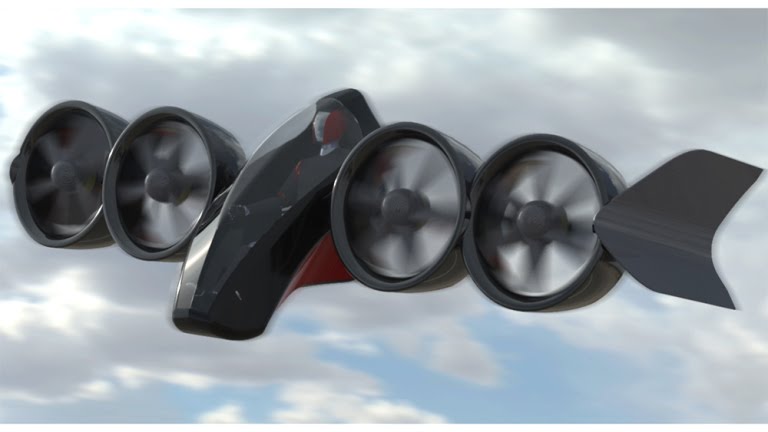
WatFly’s Atlas could be the first recreational eVTOL to market.
Want a personal-air mobility vehicle years before others will be available? A single-seat, Star-Wars-like, four-fan aircraft that can take off from the backyard, soar around the area, and then land at the golf course or marina?
WatFly’s Atlas, a one-person electric vertical takeoff and landing (eVTOL) aircraft, could be the first recreational version to market. The company expects to launch the Atlas next year with an initial price tag of $150,000.
Watfly co-founder Gonzalo Espinoza Graham said the idea behind the Atlas was born when he saw people building oversized backyard quadcopters about five years ago. “We very quickly realized that autonomous, vertical take-off and landing, electric aircraft would be the next available step, so we got to work,” he told Robb Report.
Graham focused on the smaller eVTOL Atlas because it’s easier to fly, maintain and certify. It relies on lightweight carbon fiber as the primary material, weighing only 285 lbs. The vehicle itself looks like something out of a Star Wars movie, with a height of 8.2 feet and wingspan of 15 feet. Graham and partner Abinesh Chandrasekhar chose electric power because it’s quieter and has faster control inputs. Graham says that almost anyone can fly the Atlas because it has collision-avoidance systems and an emergency parachute.
The Atlas can reach 125 mph and carry about 250 lbs. Its battery packs, about a quarter the size of a Tesla’s, recharge in two hours. It can fly for an hour and hover for about 15 minutes.
The real beauty is that the aircraft will be certified as an FAA Ultralight Part 103 aircraft, so new owners will not need a pilot’s license. The designation also means that flying is for recreation only, and the Atlas is restricted from flying over congested areas, including cities or towns, or through specific airspaces. The founders expect the Atlas to be certified by the FAA next year.

The Atlas is primarily made of carbon fiber to keep the total weight down to about 285 lbs. It has a height of about 8 feet and wingspan of 15 feet. Watfly
Graham views the Atlas as a breakthrough for the eVTOL segment since it will be available sooner than larger, commercial versions. He also sees it moving flight one step forward into the future. “Until the physicists figure out teleportation, flight is the best we can do,” he says.
By Nicolas Zart

Date trees in the Jordan Valley pollinated by Blue and White Robotics and Dropcopter (Courtesy)
Project will use drones of Tel Aviv-based Blue and White Robotics and Dropcopter’s pods to disperse pollen from air, replacing bees amid worker shortage due to coronavirus
Blue and White Robotics, a drone-maker founded by Israeli Air Force veterans, has teamed up with a Syracuse, New York-based aerial crop pollination firm to carry out a large-scale pollination project in the Jordan Valley and help date growers cope with a shortage of manpower due to the coronavirus.
The joint venture between Tel Aviv-based BWR and Syracuse’s Dropcopter will enable the artificial pollination of the dates using aerial drones, BWR said in a statement on Wednesday.
Pollination is naturally done by bees, but the bee population is declining globally. To help growers overcome this problem, Dropcopter has developed a pod to store and dispense pollen from the air, suitable for a wide range of drones.
Using BWR’s operating system and command and control centers, multiple pollination drones can fly simultaneously, providing on-site operations., the statement said.
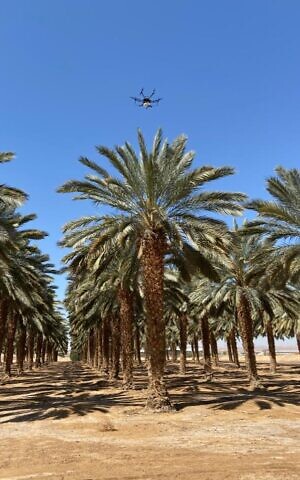
After a successful preliminary experiment conducted in recent months to test palm pollination at the Arava R&D Research Institute, led by Israeli researchers, many growers contacted BWR to request pollination services in the Jordan Valley, the statement said.
In Israel, date plantations total around 15,000 acres. Pollination, typically done using low-efficiency fans attached to tractors, is generally a four-week process, depending on weather and location, and is performed February-April. Each tree gets pollinated four times during the pollination period and requires a great deal of manpower and time that are currently unavailable due to the impact of COVID-19. The spread of the virus has closed borders and growers are finding it difficult to recruit workers locally.
In addition, heavy rain has caused flooding in the Jordan Valley, and is presenting a “significant challenge” for growers, making it “near impossible” to do ground pollination in many areas, the statement said.
Now, the process has been replaced with the new system that disperses pollen from the air, BWR said.
BWR was founded in 2017 by Ben Alfi, the CEO; Yair Shahar, the chief operating officer; and Aviram Shmueli, the chief technology officer. The firm has developed a platform to manage multiple autonomous aerial and ground tools operating in the same area, that can be remotely controlled through advanced command and control centers. BWR has customers in Israel and around the world, the statement said, and operates in the fields of agriculture, transportation, security, rescue, energy, and conducts hundreds of flights daily.
Dropcopter specializes in aerial artificial pollination of orchard crops via unmanned aircraft systems. The company conducts research into artificial pollination efficiency with the help of researchers from Cornell University and others. Dropcopter’s solution enables crops to increase yield and helps cope with the reduction of the global bee population, the statement said.
In March, BWR obtained a $1 million investment from the US-Israeli BIRD Foundation for a project between BWR Israel and Easy Aerial USA to develop a multi-mission command and control system for various types of UAVs for national security operations. The project was selected by the US Department of Homeland Security and Israel’s Ministry of Internal Security as part of the BIRD HLS program, which aims to develop advanced homeland security technologies.
By SHOSHANNA SOLOMON
The flights taking place in a COVID-19 hotspot in Connecticut use sensors to detect the virus' symptoms from afar.
A series of "pandemic drones" is taking part in a test flight in a COVID-19 hotspot in Connecticut with the goal of monitoring social distancing efforts and detecting the virus' symptoms.
Drone manufacturer Draganfly is working with the police department in Westport, Connecticut, to test the drones. Located in Fairfield County -- adjacent to New York City -- Westport was the first town in the state to report several coronavirus infections, according to a Wednesday press release from Draganfly.
The drones include specialized sensor and computer vision systems that can display a person's temperature, heart and respiratory rates, as well as detect people sneezing or coughing in a crowd, the release said. The technology can accurately detect infectious conditions from 190 feet away, as well as measure social distancing efforts, according to Draganfly.
The drones don't use facial recognition technology, and won't be used at people's private residences, according to a release from the Westport Police Department. Rather, they're used to identify patterns within the population, allowing officials to better track the spread and make decisions about public places while keeping first responders safe, the department said.
The Westport Police Department has had a drone program since 2016.
"The Westport Police Department along with first responders around the world are looking for effective ways to ease the spread of COVID-19 and keep their communities safe," Westport Chief of Police Foti Koskinas said in the Draganfly release. "This technology not only enhances the safety of our officers and the public, but the concept of using drones remains a go-to technology for reaching the most remote areas with little to no manpower needed. It also helps our officers acquire decision quality data they need to make the best choices in any given situation."
By Alison DeNisco Rayome
Autonomous drones have become a critical tool for business continuity in a wide variety of enterprise verticals. As the current crisis changes the way companies work, new tools are part of the new normal. Read on for an insider view of how industries like power and gas or critical infrastructure are continuing to function despite current limitations.
The following is a DRONELIFE exclusive guest post by Illy Gruber, business expert and V.P. of Marketing at Percepto, makers of “drone in a box” solutions to enable autonomous drone missions. DRONELIFE neither accepts nor makes payment for guest posts
Why Autonomous Drones are Now Crucial to Business Continuity
For companies that remain active and those that have temporarily shut down in light of the Coronavirus crisis, autonomous technology is playing a significant and growing role in maintaining business continuity.
Business continuity refers to how organizations can maintain or resume business functions quickly in the face of major disruptions – like, you guessed it, a pandemic. These plans, which companies spend years developing and tweaking, generally contain specific procedures and instructions that organizations need to follow as regards to infrastructure, maintenance, security, business partners, human resources, and more.
Until now, most organizations had created business continuity plans – and shelved them. Now, all of a sudden, we’re seeing the majority of SMEs, SMBs and enterprises actually implement such plans. The theory looks much different in practice, and I’m sure that companies will yet be significantly revising their plans when life returns to whatever the new normal looks like.
At Percepto, we’re seeing more and more of our customers and prospective customers turning to autonomous drones and other remote autonomous and robotic solutions to ensure business continuity. In fact, some of our customers have actually defined their autonomous drone systems as critical assets that must be kept operational under their business continuity plans.
Here’s how we’re seeing companies use autonomous drones to facilitate business continuity in the face of the Coronavirus crisis.
Security
We have a number of large industrial clients that have been forced to suspend operations owing to the pandemic. Yet at the same time, these companies own large facilities containing valuable assets that need to be actively secured – operational or not.
These companies are using autonomous drones to maintain the same high level of facility security as previously, with far less manpower. This is important not only from a worker safety point of view, but also (regrettably) owing to the massive layoffs many companies are experiencing.
Elsewhere, a large wholesale chain is using our drone technology to more tightly secure stockpiled inventory in the face of surging demand, and amid concerns about civil unrest.
Maintenance
Large industrial and critical infrastructure facilities require massive ongoing maintenance. Whether this maintenance is intended to keep facilities operational (in the case of critical infrastructure) or ensure that they can quickly spin back up after the crisis (in the case of non-essential industry) – ongoing maintenance remains mission-critical.
By way of example, some of the world’s largest mining concerns halted production last week – notably Peru and Chile’s copper mines, which account together for some 12% of global copper production. These companies have a highly distributed and massive geographic presence, with multiple remote sites packed with complex refining infrastructure that needs ongoing monitoring and at least a minimal level of maintenance. Even in normal times, effective preventative maintenance is a challenge. And when manpower is nearly non-existent owing to governmental restrictions?
We’re seeing the same trend in critical infrastructure – water, power, ports, oil & gas, and numerous other sectors. Workers are unable to get to work owing to travel restrictions or illness – yet electricity, water, goods and oil need to keep flowing, especially with large portions of the population stuck at home. Our autonomous drones are facilitating ongoing maintenance and operations for such large scale, critical infrastructure sites.
The Bottom Line
Business continuity is not just a matter of profit these days. In many sectors – both critical infrastructure and commercial – it’s a matter of life and death. We’re seeing an uptick in usage of autonomous drones, both in volume and variety of missions, to facilitate business continuity. And as this wave of COVID-19 subsides, and companies prepare for a possible second wave or future, similar crisis – autonomous drones will be part of more and more contingency plans.
By: Miriam McNabb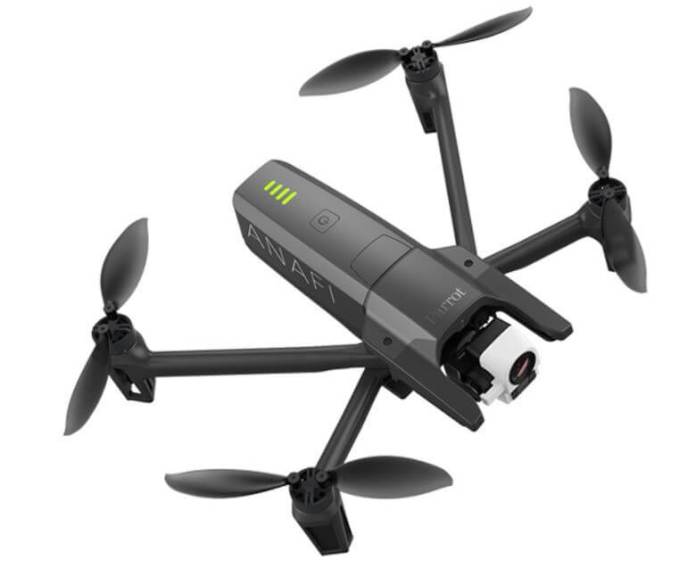
Parrot has passed another milestone in the United States Army’s Short Range Reconnaissance drone program. As the final steps of this selection process, Parrot will participate in an operational assessment to support an Army production award decision. In anticipation of an increased demand signal from the Department of Defence, Parrot will start manufacturing prototypes of its dedicated drone in the United States of America.
The mature prototype presented by Parrot, designed with carefully selected components, has now been approved for initial manufacturing. To support Parrot’s commitment to U.S. industry capabilities, Parrot is currently finalising its U.S. production chain with its partner NEOTech to build its final prototype batch for delivery to the U.S. Army and the Defense Innovation Unit in July 2020. The final prototype assembly includes the installation at NEOTech facility of all software developed by Parrot in Paris (France) ensuring high IP protection with no data dissemination. NeoTech and Parrot are also partnering to achieve the highest quality standard in the industry, to meet the U.S. Army requirements.
With over 40 years of heritage in electronics manufacturing, NEOTech specialises in high-reliability programs primarily in the Aerospace and Defence industry, Medical Products, and High-Tech Industrial markets. NEOTech has a highly talented engineering group and multiple manufacturing locations throughout the U.S., and is well recognised for its excellent customer service and high-level industry specific certifications. This partnership agreement reinforces Parrot’s strategy to expand in the U.S. through a dedicated approach of the Defence & Security markets.
“Parrot is honored to work with the DoD on this highly strategic project,” said Laurent Rouchon, VP Security & Defence at Parrot. “We have successfully met the high standards set over the last 12 months on the prototype efforts and we look forward to entering this final phase and launching production in the USA.”
In April 2019, the U.S. Army and the Defence Innovation Unit selected Parrot and 5 additional commercial drone manufacturers to develop Short Range Reconnaissance prototype drones for military use. As a result of the award, Parrot developed a prototype of the drone between May and November of 2019. Parrot focused the company’s Paris based research and development efforts toward engineering a drone dedicated to the U.S. Army specifications. A prototype unit was finalised in November 2019, and the initial testing phase continued through January 2020. The initial positive results have encouraged Parrot to begin exploring the industrialisation phase in early 2020.
For further information, please follow this link to the Parrot blog: https://blog.parrot.com/2020/04/15/parrot-srr-neotech/
***
About Parrot
Founded in 1994 by Henri Seydoux, Parrot is today the leading European group in the fast-growing industry of drones. Visionary, at the forefront of innovation, Parrot is the only group to be positioned across the entire value chain, from equipment to services and software. Its microdrones, recognised for their performance and robustness, address consumer and professional uses. The Group also has a set of advanced professional solutions (drones, sensors, software) intended for businesses, large corporations and governments. Its expert solutions are focused primarily on three vertical markets: (i) Agriculture, (ii) 3D Mapping, Surveying and Inspection, and (iii) Defense and Security.
The Parrot Group designs and engineers its products in Europe, mainly in France and Switzerland. It currently employs over 500 people worldwide and makes the majority of its sales outside of France. Parrot, headquartered in Paris, has been listed since 2006 on Euronext Paris (FR0004038263 – PARRO).
To learn more, visit: www.parrot.com and these subsidiaries www.pix4d.com, www.sensefly.com, www.micasense.com.
About NEOTech
NEOTech combines the strengths of three leading contract manufacturers: NATEL, EPIC, and OnCore. With their position and experience as an industry-leader in electronics manufacturing, NEOTech focuses on low-to-medium volume – high-mix designs for high-complexity/high-reliability products primarily in the defense/aerospace, industrial and medical industries.
NEOTech offers a wide array of design and manufacturing services including: full product lifecycle engineering services, manufacturing and testing of microelectronics, cable & harness interconnect products, PCBA, full box build services and aftermarket repair and fulfillment services. NEOTech and its over 3,800 employees are dedicated to solve tough engineering problems, providing customers with high-reliability, high-quality electronic solutions.
Headquartered in Chatsworth, CA, NEOTech has engineering locations and manufacturing locations in California, Colorado, Illinois, Massachusetts, Nevada, Ohio, Mexico, and China. NEOTech holds and maintains industry specific certifications that include ISO9001, AS9100, ISO13485, ISO14001 and MIL-PRF-38534.
To learn more, visit www.NEOTech.com
By PRESS